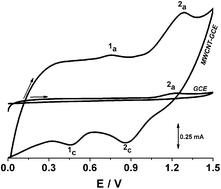Electroanalytical determination of carbendazim by square wave adsorptive stripping voltammetry with a multiwalled carbon nanotubes modified electrode
Abstract
A preconcentrating/voltammetric multiwalled

* Corresponding authors
a
Universidade Federal da Paraíba, CCEN, Departamento de Química, João Pessoa, PB, Brazil
E-mail:
laqa@quimica.ufpb.br
Fax: +55-83-3216-7437
Tel: +55-83-3216-7438
b Universidade Federal Rural de Pernambuco, Departamento de Química, Recife, PE, Brazil
c Universidade Federal de Alagoas, CCEN, Departamento de Química, Maceió, AL, Brazil
A preconcentrating/voltammetric multiwalled

 Please wait while we load your content...
Something went wrong. Try again?
Please wait while we load your content...
Something went wrong. Try again?
W. F. Ribeiro, T. M. G. Selva, I. C. Lopes, E. C. S. Coelho, S. G. Lemos, F. Caxico de Abreu, V. Bernardo do Nascimento and M. C. Ugulino de Araújo, Anal. Methods, 2011, 3, 1202 DOI: 10.1039/C0AY00723D
To request permission to reproduce material from this article, please go to the Copyright Clearance Center request page.
If you are an author contributing to an RSC publication, you do not need to request permission provided correct acknowledgement is given.
If you are the author of this article, you do not need to request permission to reproduce figures and diagrams provided correct acknowledgement is given. If you want to reproduce the whole article in a third-party publication (excluding your thesis/dissertation for which permission is not required) please go to the Copyright Clearance Center request page.
Read more about how to correctly acknowledge RSC content.
 Fetching data from CrossRef.
Fetching data from CrossRef.
This may take some time to load.
Loading related content
